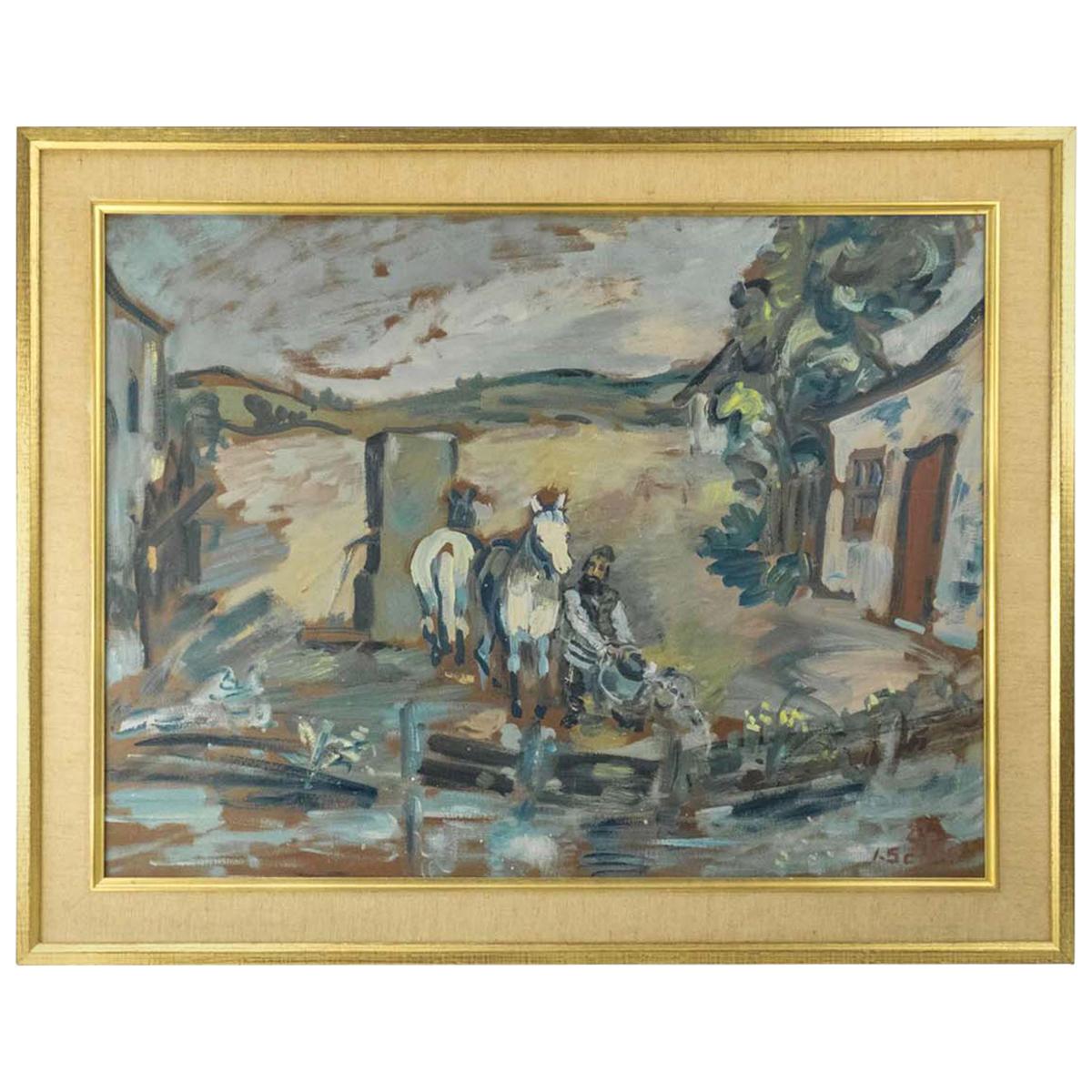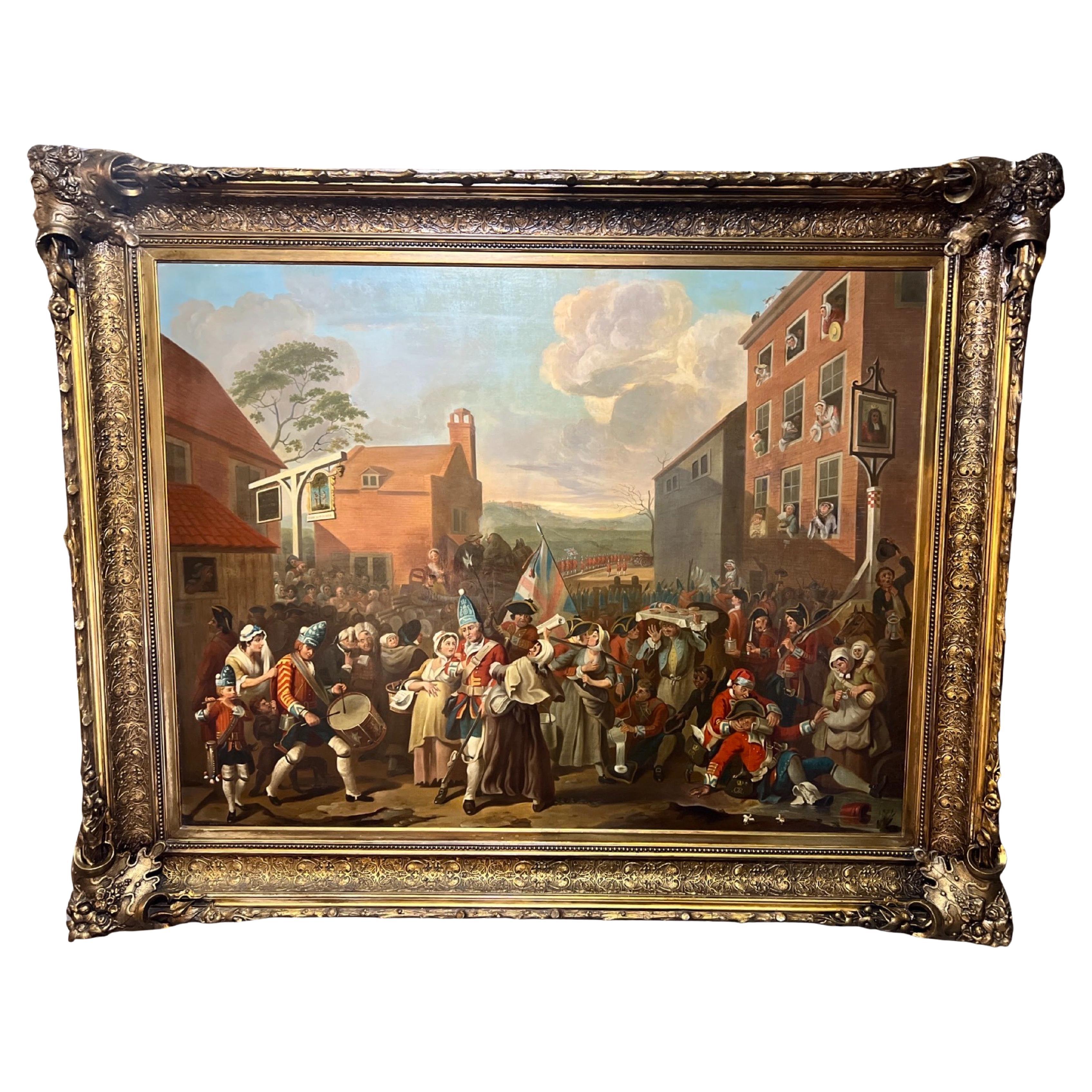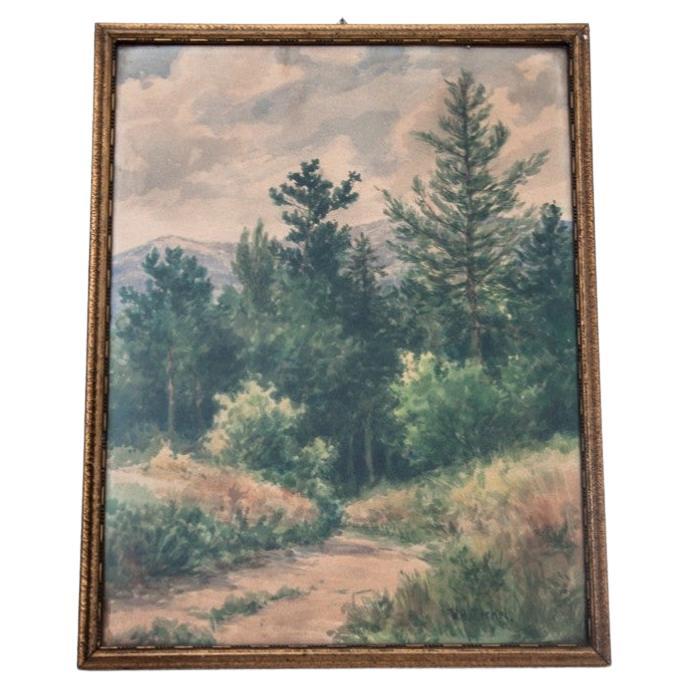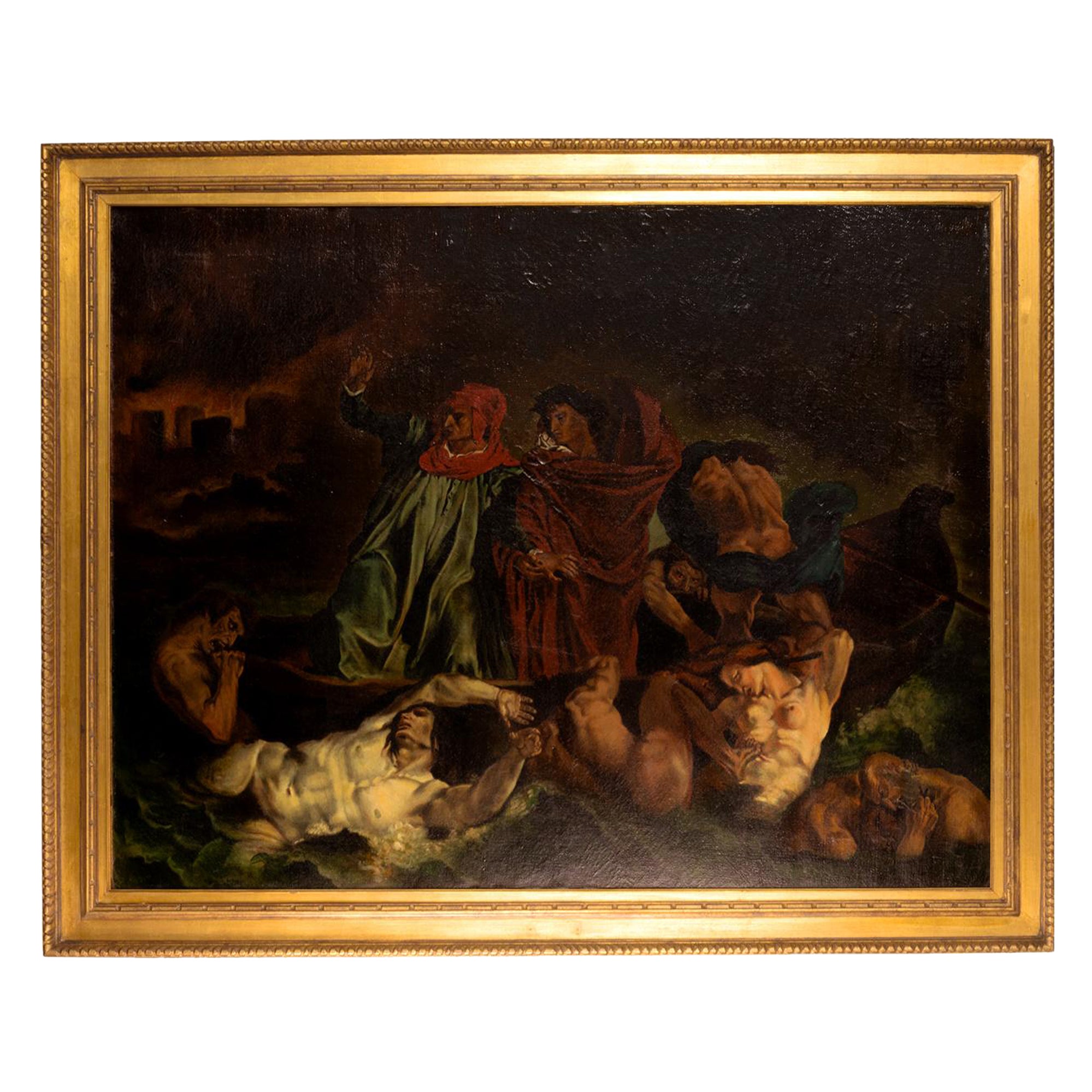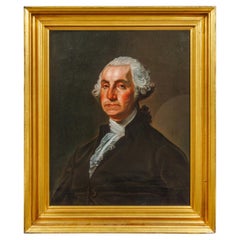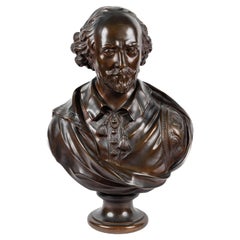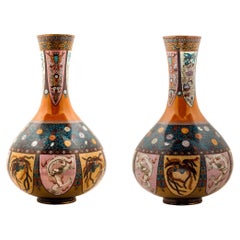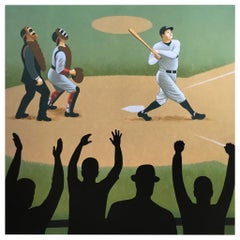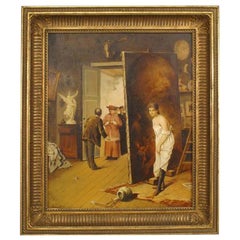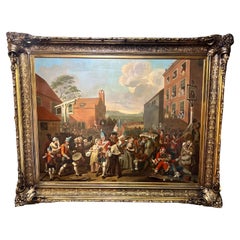Items Similar to Reply of the Zaporozhian Cossacks to Sultan Mehmed IV Painting after Ilya Repin
Want more images or videos?
Request additional images or videos from the seller
1 of 6
Reply of the Zaporozhian Cossacks to Sultan Mehmed IV Painting after Ilya Repin
About the Item
Reply of the Zaporozhian Cossacks to Sultan Mehmed IV of the Ottoman Empire, also known as Cossacks of Saporog Are Drafting a Manifesto.
Late 19th Century.
Monumental oil on canvas, set within an original carved giltwood frame. Unsigned.
Measures: Canvas: 62 X 105in (157 X 266cm).
Frame: 80 X 123in (204 X 312cm).
This painting is after Russian artist Ilya Repin. The Original 2.03 m (6.66 ft) by 3.58 m (11.74 ft) canvas was started in 1880 and finished in 1891. Repin recorded the years of work along the lower edge of the canvas. Alexander III bought the painting for 35,000 rubles, at the time the greatest sum ever paid for a Russian painting. Since then, the canvas has been exhibited in the State Russian Museum in Saint Petersburg. Vladimir Gilyarovsky, a popular journalist, was one of the models who posed for Repin.
Reply of the Zaporozhian Cossacks depicts a supposedly historical tableau, set in 1676 and based on the legend of Cossacks sending a reply to an ultimatum of the Sultan of the Ottoman Empire, Mehmed IV.
The painting exhibits the Cossacks' pleasure at striving to come up with ever more base vulgarities. During Repin's time, the Cossacks enjoyed great popular sympathy.
While working on the original version, Repin in 1889 began work on a second version. This work he never finished. The second version of "The Cossacks" the artist tried to make more "historically authentic". In 1932 it was presented by the Tretyakov Gallery to the Kharkiv Historical Museum. In 1935, it was moved to the Kharkiv Art Museum, where it is now stored.
- Attributed to:Ilya Repin (Artist)
- Dimensions:Height: 80 in (203.2 cm)Width: 123 in (312.42 cm)Depth: 5 in (12.7 cm)
- Materials and Techniques:
- Place of Origin:
- Period:
- Date of Manufacture:1880-1890
- Condition:Wear consistent with age and use.
- Seller Location:New York, NY
- Reference Number:1stDibs: LU179824235883
About the Seller
5.0
Gold Seller
Premium sellers maintaining a 4.3+ rating and 24-hour response times
Established in 1980
1stDibs seller since 2016
63 sales on 1stDibs
Typical response time: <1 hour
- ShippingRetrieving quote...Shipping from: New York, NY
- Return Policy
Authenticity Guarantee
In the unlikely event there’s an issue with an item’s authenticity, contact us within 1 year for a full refund. DetailsMoney-Back Guarantee
If your item is not as described, is damaged in transit, or does not arrive, contact us within 7 days for a full refund. Details24-Hour Cancellation
You have a 24-hour grace period in which to reconsider your purchase, with no questions asked.Vetted Professional Sellers
Our world-class sellers must adhere to strict standards for service and quality, maintaining the integrity of our listings.Price-Match Guarantee
If you find that a seller listed the same item for a lower price elsewhere, we’ll match it.Trusted Global Delivery
Our best-in-class carrier network provides specialized shipping options worldwide, including custom delivery.More From This Seller
View AllGeorge Washington, A Masterful Portrait by The Circle of Gilbert Stuart C. 1820
By Gilbert Stuart
Located in New York, NY
George Washington: A Masterful Portrait from the Circle of Gilbert Stuart, Circa 1820
This distinguished oil on canvas portrait of George Washington, dating to circa 1820, is in the...
Category
Antique 19th Century American Empire Paintings
Materials
Canvas, Giltwood, Paint
Emanuel Oberhauser, Full Length Portrait of an "Orientalist Queen" Oil on Canvas
Located in New York, NY
Emanuel Oberhauser (Austrian, 1854-1919) an exceptional quality full length oil on canvas painting of a Young Orientalist Queen or Odalisque, 19th c...
Category
Antique 19th Century Austrian Paintings
Materials
Paint
Monumental French Patinated Bronze Bust of William Shakespeare, After Houdon
By F. Barbedienne Foundry
Located in New York, NY
A monumental French patinated bronze bust of William Shakespeare, after Houdon, by F. Barbedienne Foundry, circa 1870.
Masterfully and realistically sculpted in solid bronze, this...
Category
Antique 19th Century French Napoleon III Busts
Materials
Bronze
$16,250 Sale Price
35% Off
Large Pair of Japanese Cloisonne Enamel Vases Attributed to Honda Yasaburo
Located in New York, NY
A large pair of Japanese Cloisonne Enamel vases attributed to Honda Yasaburo, 19th century.
Finley decorated with the rich enamel colors of orange and green, these vases are desig...
Category
Antique 19th Century Japanese Meiji Metalwork
Materials
Copper, Enamel
Large Pair of Japanese Cloisonne Enamel Lanterns Attributed to Kaji Tsunekichi
Located in New York, NY
A Large Pair of Japanese Cloisonne Enamel Lanterns Attributed to Kaji Tsunekichi, Edo Period, 19th century
Japanese cloisonne lanterns were made during the Meiji period, from the late 19th to early 20th century, and were often used as decorative lighting fixtures in temples and shrines.
Kaji Tsunekichi (1866-1916) was a Japanese cloisonné artist who was active in the late 19th and early 20th centuries. He was born in Tokyo and learned the art of cloisonné from his father, Kaji Sataro, who was also a cloisonné artist. He was renowned for his mastery of the shippo-yaki technique, which involves creating intricate designs with thin wires on a metal base before filling in the spaces with enamel.
Tsunekichi was known for his exceptional technical skills and his ability to create intricate designs with vibrant colors. His works often featured nature motifs, such as flowers, birds, and fish, which were rendered in a highly detailed and naturalistic style. He also experimented with new techniques, such as plique-à-jour, a type of cloisonné that creates a stained-glass effect.
Tsunekichi's works were highly prized during his lifetime and continue to be sought after by collectors today. He won numerous awards for his cloisonné creations, including a Gold Medal at the 1900 Exposition Universelle in Paris. His works are characterized by their fine wirework, precise enamel application, and attention to detail.
Some of Tsunekichi's most famous works include a pair of large cloisonné vases...
Category
Antique 19th Century Japanese Edo Metalwork
Materials
Copper, Enamel
Large Pair of Meiji Period Japanese Cloisonne Enamel Vases Attributed to Goto
Located in New York, NY
A large pair of Meiji Period Japanese cloisonne enamel vases attributed to Goto Seizaburo, 19th century.
These vases were made during the Meiji period (1868-1912) in Japan and are characterized by their blue enamel background with intricate designs of flowers, birds (including pigeons), butterflies and landscapes.
The use of blue enamel as a background creates a striking contrast with the colorful designs, making these vases particularly visually appealing which are appreciated for their beauty, craftsmanship, and cultural significance.
Goto Seizaburo (1852-1914) was a renowned Japanese cloisonne enamel artist...
Category
Antique 19th Century Japanese Meiji Metalwork
Materials
Copper, Enamel
$20,000 Sale Price
20% Off
You May Also Like
Shtetl, Oil Painting by Ilya Schor
Located in New York, NY
Oil on board, New York, circa 1950.
Depicting a standing bearded man wearing his tzitzis over his shirt pumping water to his horses.
Signed lower right “I. Schor”. Ilya Schor (1904-...
Category
Mid-20th Century American Paintings
Materials
Paint
Babe Ruth, the Sultan of Swat, Original Painting by Lynn Curlee
By Lynn Curlee
Located in New York, NY
Babe Ruth — The Sultan of Swat
Original painting by Lynn Curlee
Acrylic on stretched canvas. Gallery wrapped with painted edges.
This painting was used as...
Category
Early 2000s American Modern Paintings
Materials
Acrylic
The Visit to the Studio Painting
Located in Queens, NY
Copy of an interior scene painting titled " The Visit to the Studio" of an artist's model hiding as priest and followers greet artist at door.
Category
Late 20th Century American Victorian Paintings
Materials
Paint
Monumental 19th C., "The March of the Guards to Finchley" After William Hogarth
By William Hogarth
Located in Atlanta, GA
After William Hogarth (English, 1697-1764), originally done circa 1750 - this is likely done in the mid 1800's.
"The March of the Guards to Finchley, also known as The March to Finc...
Category
Antique 19th Century British British Colonial Paintings
Materials
Canvas, Giltwood, Paint
$6,160 Sale Price
20% Off
The painting "The road to the forest".
Located in Chorzów, PL
The picture is painted with oil paint on canvas.
Origin : Scandinavia
Dimensions:
Frame: height 58 cm / width 45 cm
Image: height 54 cm / width 41 cm
Category
Vintage 1950s Scandinavian Other Paintings
Materials
Canvas
$232 Sale Price
20% Off
The Barque of Dante Oil Painting After Eugéne Delacroix
Located in Lisbon, PT
A very large antique reproduction oil painting after Eugéne Delacroix. Apty titled "The Barque of Dante (French: La Barque de Dante)" features an antiqued canvas.
Frame: 166 cm (65....
Category
Early 20th Century French Paintings
Materials
Canvas, Wood
